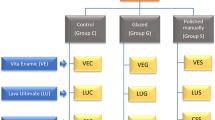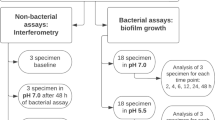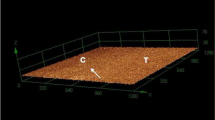Abstract
The aim of this in vitro study was to investigate the influence of artificial ageing on the surface properties and early Streptococcus mutans adhesion to current dental composites for the direct restoration of class II defects. Three hundred and thirty specimens each were prepared from five dental composites, and were randomly allotted to various artificial ageing protocols (storage in distilled water/ethanol/artificial saliva for 7/90/365 days; thermal cycling, 6,000 cycles 5/55°C). Prior and after each treatment, surface roughness (Ra) and hydrophobicity were determined, and S. mutans adhesion (ATCC 25175; 2.5 h, 37°C) was simulated with and without prior exposition to human whole saliva (2 h, 37°C). Adherence of S. mutans was determined fluorometrically. Means and standard deviations were calculated, and analyzed using three-way ANOVA and post-hoc analysis (α = 0.05). For both Ra and S. mutans adherence to uncoated and saliva-coated specimens, significant influences of the composite material, the ageing medium and the ageing duration have been observed; for surface hydrophobicity, significant influences of the composite material and the ageing duration were found. For uncoated specimens, significant increases in S. mutans adhesion were observed with prolonged artificial ageing, whereas significant decreases in S. mutans adhesion were found for the saliva-coated specimens. The data indicate influences of the artificial ageing method on surface parameters such as Ra and hydrophobicity as well as microbial adhesion. The results underline the relevance of saliva coating on the outcome of studies simulating microbial adhesion, and highlight differences in the susceptibility of dental composites for the adhesion of oral bacteria.


Similar content being viewed by others
References
Sattabanasuk V, Shimada Y, Tagami J. Effects of saliva contamination on dentin bond strength using all-in-one adhesives. J Adhes Dent. 2006;8:311–8.
Pereira RA, Araujo PA, Castaneda-Espinosa JC, Mondelli RF. Comparative analysis of the shrinkage stress of composite resins. J Appl Oral Sci. 2008;16:30–4.
Sun J, Eidelman N, Lin-Gibson S. 3D mapping of polymerization shrinkage using X-ray micro-computed tomography to predict microleakage. Dent Mater. 2009;25:314–20.
Yesil ZD, Alapati S, Johnston W, Seghi RR. Evaluation of the wear resistance of new nanocomposite resin restorative materials. J Prosthet Dent. 2008;99:435–43.
Schmalz G. The biocompatibility of non-amalgam dental filling materials. Eur J Oral Sci. 1998;106:696–706.
Guggenberger R, Weinmann W. Exploring beyond methacrylates. Am J Dent. 2000;13:82D–4D.
Weinmann W, Thalacker C, Guggenberger R. Siloranes in dental composites. Dent Mater. 2005;21:68–74.
Eick JD, Smith RE, Pinzino CS, Kostoryz EL. Stability of silorane dental monomers in aqueous systems. J Dent. 2006;34:405–10.
Manhart J, Kunzelmann CH, Chen Hy, Hickel R. Mechanical properties of new composite restorative materials. J Biomed Mater Res. 2000;53:353–61.
Ferracane JL, Berge HX, Condon JR. In vitro aging of dental composites in water—effect of degree of conversion, filler volume, and filler/matrix coupling. J Biomed Mater Res. 1998;42:465–72.
Schulze KA, Marshall SJ, Gansky SA, Marshall GW. Color stability and hardness in dental composites after accelerated aging. Dent Mater. 2003;19:612–9.
Drummond JL, Andronova K, Al-Turki LI, Slaughter LD. Leaching and mechanical properties characterization of dental composites. J Biomed Mater Res B. 2004;71B:172–80.
Ravindranath V, Gosz M, Santiago ED, Drummond JL, Mostovoy S. Effect of cyclic loading and environmental aging on the fracture toughness of dental resin composite. J Biomed Mater Res B. 2007;80B:226–35.
Sideridou ID, Karabela MM, Bikiaris DN. Aging studies of light cured dimethacrylate-based dental resins and a resin composite in water or ethanol/water. Dent Mater. 2007;23:1142–9.
Zhang Y, Xu J. Effect of immersion in various media on the sorption, solubility, elution of unreacted monomers, and flexural properties of two model dental composite compositions. J Mater Sci Mater Med. 2008;19:2477–83.
Hannig M. Transmission electron microscopy of early plaque formation on dental materials in vivo. Eur J Oral Sci. 1999;107:55–61.
Van Dijk LJ, Herkströter F, Busscher HJ, Weerkamp AH, Jansen HWB, Arends J. Surface free energy and bacterial adhesion—an in vivo study in beagle dogs. J Clin Periodontol. 1987;14:300–4.
Bollen CML, Lambrechts P, Quirynen M. Comparison of surface roughness of oral hard materials to the threshold surface roughness for bacterial plaque retention: a review of the literature. Dent Mater. 1997;13:258–69.
Teughels W, van Assche N, Sliepen I, Quirynen M. Effect of material characteristics and/or surface topography on biofilm development. Clin Oral Implants Res. 2006;17:68–81.
Absolom DR, Lamberti FV, Policova Z, Zingg W, van Oss CJ, Neumann AW. Surface thermodynamics of bacterial adhesion. Appl Environ Microbiol. 1983;46:90–7.
Weerkamp AH, Uyen HM, Busscher HJ. Effect of zeta potential and surface free energy on bacterial adhesion to uncoated and saliva-coated human enamel and dentin. J Dent Res. 1988;67:1483–7.
Mabbaux F, Ponsonnet L, Morrier JJ, Jaffrezic N, Barsotti O. Surface free energy and bacterial retention to saliva-coated dental implant materials—an in vitro study. Coll Surf B. 2004;39:199–205.
Axelsson P, Lindhe J. Effect of controlled oral hygiene procedures on caries and periodontal disease in adults. J Clin Periodontol. 1978;5:133–51.
Drummond JL. Degradation, fatigue, and failure of resin dental composite materials. J Dent Res. 2008;87:710–9.
Arvidson K, Johansson EG. Galvanic currents between dental alloys in vitro. Scand J Dent Res. 1985;93:467–73.
Hahnel S, Rosentritt M, Handel G, Bürgers R. In vitro evaluation of artificial ageing on surface properties and early Candida albicans adhesion to prosthetic resins. J Mater Sci Mater Med. 2009;20:249–55.
Wataha JC, Rueggeberg FA, Lapp CA, Lewis JB, Lockwood PE, Ergle JW, et al. In vitro cytotoxicity of resin-containing restorative materials after aging in artificial saliva. Clin Oral Invest. 1999;3:144–9.
Stinson MW, Levine MJ, Cavese JM, Prakobphol A, Murray PA, Tabak LA, et al. Adherence of Streptococcus sanguis to salivary mucins bound to glass. J Dent Res. 1982;61:1390–3.
Satou J, Fukunaga A, Satou N, Shintani H, Okuda K. Streptococcal adherence on various restorative materials. J Dent Res. 1988;67:588–91.
Hahnel S, Rosentritt M, Bürgers R, Handel G. Surface properties and in vitro Streptococcus mutans adhesion to dental resin polymers. J Mater Sci Mater Med. 2008;19:2619–27.
Hahnel S, Rosentritt M, Bürgers R, Handel G. Adhesion of Streptococcus mutans NCTC 10449 to artificial teeth: an in vitro study. J Prosthet Dent. 2008;100:309–15.
Bürgers R, Schneider-Brachert W, Rosentritt M, Handel G, Hahnel S. Candida albicans adhesion to composite resin materials. Clin Oral Invest. 2008. doi: 10.1007/s00784-008-0226-4.
Leung VW, Darvell BW. Artificial salivas for in vitro studies of dental materials. J Dent. 1997;25:475–84.
Rosentritt M, Behr M, van der Zel JM, Feilzer AJ. Approach for valuating the influence of laboratory simulation. Dent Mater. 2009;25:348–52.
Yip HK, To WM, Smales RJ. Effects of artificial saliva and APF gel on the surface roughness of newer glass ionomer cements. Oper Dent. 2004;29:661–8.
Tari BF, Nalbant D, Dogruman AF, Kustimur S. Surface roughness and adherence of Candida albicans on soft lining materials as influenced by accelerated aging. J Contemp Dent Pract. 2007;8:18–25.
Zanin FR, Garcia LF, Casemiro LA, Pires-de-Souza FC. Effect of artificial accelerated aging on color stability and surface roughness of indirect composites. Eur J Prosthodont Restor Dent. 2008;16:10–4.
Bürgers R, Cariaga T, Müller R, Rosentritt M, Reischl U, Handel G, Hahnel S. Effects of aging on surface properties and adhesion of Streptococcus mutans on various fissure sealants. Clin Oral Invest. 2009. doi:10.1007/s00784-009-0256-6.
Wu W, McKinney JE. Influence of chemicals on wear of dental composites. J Dent Res. 1982;61:1180–3.
Dawes C, Jenkins GN, Tonghe CH. The nomenclature of the integuments of the enamel surface of teeth. Br Dent J. 1963;16:65–8.
Satou J, Fukunaga A, Morikawa A, Matsumae I, Satou N, Shintani H. Streptococcal adherence to uncoated and saliva-coated restoratives. J Oral Rehabil. 1991;18:421–9.
Hahnel S, Leyer A, Rosentritt M, Handel G, Bürgers R. Surface properties and in vitro Streptococcus mutans adhesion to self-etch adhesives. J Adhes Dent. 2009;11:263–9.
Sönju T, Rölla G. Chemical analysis of the acquired pellicle formed in two hours on cleaned human teeth in vivo. Rate of formation and amino acid analysis. Caries Res. 1973;7:30–8.
Kuboki Y, Teraoka K, Okada S. X-ray photoelectron spectroscopic studies of the adsorption of salivary constituents on enamel. J Dent Res. 1987;66:1016–9.
De Stoppelaar JD, van Houte J, Backer Dirks O. The relationship between extracellular polysaccharide-producing streptococci and smooth surface caries in 13-year-old children. Caries Res. 1969;3:190–9.
Nyvad B, Kilian M. Comparison of the initial streptococcal microflora on dental enamel in caries-active and caries-inactive individuals. Caries Res. 1990;24:267–72.
Grivet M, Morrier JJ, Benay G, Barsotti O. Effect of hydrophobicity on in vitro streptococcal adhesion to dental alloys. J Mater Sci Mater Med. 2000;11:637–42.
Busscher HJ, van de Belt-Gritter B, Dijkstra RJB, Norde W, van der Mei HC. Streptococcus mutans and Streptococcus intermedius adhesion to fibronectin films are oppositely influenced by ionic strength. Langmuir. 2008;24:10968–73.
Carlèn A, Nikdel K, Wennerberg A, Holmberg K, Olsson J. Surface characteristics and in vitro biofilm formation on glass ionomer and composite resin. Biomaterials. 2001;22:481–7.
Pratt-Terpstra IH, Weerkamp AH, Busscher HJ. Adhesion of oral streptococci from a flowing suspension to uncoated and albumin-coated surfaces. J Gen Microbiol. 1987;133:3199–206.
Gröger G, Rosentritt M, Behr M, Schröder J, Handel G. Dental resin materials in vivo—TEM results after one year: a pilot study. J Mater Sci Mater Med. 2006;17:825–8.
Waltimo T, Vallittu P, Haapasalo M. Adherence of Candida species to newly polymerized and water-stored denture base polymers. Int J Prosthodont. 2001;14:457–60.
Nikawa H, Jin C, Makihira S, Egusa H, Hamada T, Kumagai H. Biofilm formation of Candida albicans on the surfaces of deteriorated soft denture lining materials caused by denture cleansers in vitro. J Oral Rehabil. 2003;30:243–50.
Söderholm KJM, Mukherjee R, Longmate J. Filler leachability of composites stored in distilled water or artificial saliva. J Dent Res. 1996;75:1692–9.
Acknowledgements
The composite materials used in this study were kindly provided by the manufacturers.
Author information
Authors and Affiliations
Corresponding author
Rights and permissions
About this article
Cite this article
Hahnel, S., Henrich, A., Rosentritt, M. et al. Influence of artificial ageing on surface properties and Streptococcus mutans adhesion to dental composite materials. J Mater Sci: Mater Med 21, 823–833 (2010). https://doi.org/10.1007/s10856-009-3894-y
Received:
Accepted:
Published:
Issue Date:
DOI: https://doi.org/10.1007/s10856-009-3894-y




